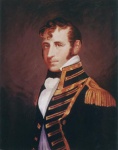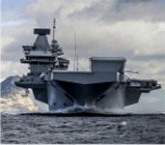-
 On This Day 12 December
On This Day 12 December
The Action of 12 December 1782 was a naval engagement fought off the coast of Spain near Ferrol, in which the British 40-gun fifth rate HMS Mediator successfully attacked a convoy of five armed ships. Mediator succeeded in capturing one American privateer, the Alexander, and then captured the French ex-ship of the line La Ménagère. The convoy was part of Pierre Beaumarchais's supply chain to the American colonists.
The Frenchman Pierre Beaumarchais founded a commercial enterprise, Roderigue Hortalez and Co., supported by France and Spain. The French and Spanish supplied the American rebels with weapons, munitions, clothes, and provisions that would never be paid for. Beaumarchais contracted for the transport of the supplies in convoys. Even so, the Royal Navy captured many of the transport vessels.
Baumarchais assembled one convoy in December 1782. He met his captains in Bordeaux and then supervised the loading of his vessels. The plan was to sail for Port-au-Prince, Saint Domingue and then on to America to supply the American colonists.
The convoy consisted of five ships:
Alexander was a corvette that Beaumarchais purchased in 1781 a Bordeaux. She was under the command of Commander Stephen Gregory, who had an American privateer commission issued in France (a "Congress" commission) and sailed under a French ensign and an American pennant. She had a mixed American and French crew of 102 men and was armed with twenty-four long 9-pounder guns. She was of about 500 tons burthen and carried a cargo of stores and provisions.
Aimable Eugénie, which was named after Beaumarchais' daughter, was under the command of Nicolas Baudin. She mounted 36 guns and had a crew of 130 men; she was the primary escort for the convoy. Beaumarchais had bought her at Nantes in March 1782 for £t300,000.
Ménagère, which was under the command of François Jérome Foligné-Deschalonges, had a burthen of 600 tons (bm) and was a two decked vessel, launched in 1775 or '76. She was a former 64-gun ship of the line, and now armed en flûte, with twenty-six 12-pounders on her main deck and four 6-pounders on her forecastle and quarterdeck. She had a crew of 212 men and carried 100 tons of gunpowder plus naval stores and bale goods.
Dauphin Royal was under the command of Antoine Chambert. She was a transport purchased and armed at Bordeaux for the Marine Royale.[6] She was of 300 tons burthen (bm), armed with twenty-eight guns and carried a crew of 120 men.
The convoy also included an unknown American privateer brig with 14 guns and a crew of 70 men.
On 9 December 1782 the convoy sailed from the mouth of the Gironde for the West Indies and from there America. On 12 December, at 7:00am, HMS Mediator, under the command of James Luttrell, was sailing off Ferrol when she sighted the convoy.
At 8:00am the convoy formed in line of battle. Not withstanding this formidable array, Captain Luttrell continued bearing down and at 10:00am Ménagère initiated the action. Luttrell saw that the shot came from the upper deck only and rightly concluded that the French vessel had no lower-deck guns. Mediator bore up in order to bring the rear ship to action.
At 10:30 Mediator opened fire on Dauphin Royal when that ship and the Alexander bore up out of the line. Aimable Eugénie, Ménagère and the American brig then wore and endeavored to protect the two rear ships.
Mediator fought her way through the Franco-American line. At 11a.m. Luttrell was able to cut off Alexander and compelled her to strike. He then took possession of the Alexander while the rest of the French and American vessels were trying to escape before the wind. Once Luttrell had succeeded in removing the prisoners and placing a prize-master and crew on board Alexander, he pursued the retreating ships.
At 3:00pm the Aimable Eugénie hauled off the wind in full sail. Mediator then followed Ménagère. At 5p.m. he got within gunshot of Ménagère and started a running fight. At 9:00pm Mediator, having got up with the Ménagère, was on the point of firing a full broadside. Before she could do so Ménagère struck. At this point the action ended.
Because the enemy fired high in an attempt to damage Mediator's rigging, she sustained no casualties. Ménagere had four men killed and seven or eight wounded. Alexandre had six killed and eight or nine wounded.
Dauphin Royal and the American brig were seen next morning severely damaged but only five miles from Ferrol. However Luttrell judged it prudent to make sail for England with his two prizes. He had 340 prisoners on board and only 100 men to guard them while being close to Spain.
Mediator sustained only seven casualties in her crew but was cut up in the riggings in masts which had been the target of the French and American ships. Alexander had six men killed and nine wounded; Ménagère had a passenger returning to Saint-Domingue and three seamen killed, and several men wounded.
Despite being well-treated, Captain Gregory organized a party of the prisoners in an attempt to gain possession of Mediator. He was subdued but then unsuccessfully attempted to set fire to the ship. After this Luttrell had Gregory and the American prisoners placed in irons. Although the French officers played no part in the attempt, the British also guarded them more closely. Michael Seymour, who was later to be a rear admiral, served as a midshipman in HMS Mediator.
Aimable Eugénie reached Saint-Domingue in March 1783, where she wrecked on the coastal reef at Porto Plata.
Luttrell and his crew received the last of the prize money for Alexandre and Ménagere in October 1788.
The action was the final clash of arms in which American forces were engaged before the Treaty of Paris concluded the American Revolutionary War.

-

The Second Battle of Ushant was a naval battle fought between French and British squadrons near Ushant on 12 December 1781, during the American War of Independence.
A French convoy sailed from Brest on 10 December with reinforcements and stores for the East and West Indies, protected by a fleet of 19 ships of the line commanded by Comte de Guichen. The British squadron of 13 ships of the line, commanded by Rear Admiral Richard Kempenfelt in HMS Victory, which had been ordered to sea to intercept the expected convoy, sighted the French on 12 December, discovering only then that the protective escort had been strengthened. De Guichen's fleet was downwind of the convoy, which let the British ships sweep down to capture 15 ships carrying troops and supplies, before the French ships could intervene.
Kempenfelt's force was not strong enough to attack the 19 French escorts, but fortunately for Britain, the convoy, which had deliberately risked setting sail in the North Atlantic storm season to avoid British forces, was dispersed in a gale shortly afterwards, and most of the ships forced to return to port. Only two of the ships of the line intended for the West Indies arrived with a few transport vessels in time for the Battle of the Saintes in April. When news of the battle reached Britain, the Opposition in Parliament questioned the sending of such a small force against the convoy, and forced an official inquiry into the administration of the Royal Navy. This was the first of a succession of Opposition challenges which would ultimately bring about the fall of the government of Lord North on 20 March 1782 and pave the way for the Peace of Paris (1783), which ended the American Revolutionary War.
-

On 12 December 1798 the corvette HMS Perdrix, under Lieutenant Charles Peterson, took the privateer L'Armée d' Italie. Perdrix was armed with 24 guns. L'Armée d' Italie was armed with fourteen 9-pounder and four 12-pounder guns.
-

Also on this day...
1779 - HMS Salisbury captured the Spanish privateer San Carlos 20 miles NW of Punta de la Sal in the Gulf of Honduras.
1809 - HM Ships Thetis, Achates, Attentive, Bacchus and Pultusk captured the French Nissus and destroyed shore batteries at Deshayes, Guadeloupe
1810 - HMS Entreprenante (10) engaged four French privateers between Malaga and Almeria
1811 - The French lugger, Le Brave (16) was captured by HMS Desiree (36), Captain. Arthur Farquhar.
 Posting Permissions
Posting Permissions
- You may not post new threads
- You may not post replies
- You may not post attachments
- You may not edit your posts
-
Forum Rules







 Reply With Quote
Reply With Quote

Bookmarks